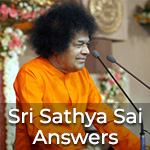DiscoursesSevadal Conference
[audio src="https://wpstatic.ssssoindia.org/wp-content/uploads/2022/04/17170934/B3.21-1976_10_01_02.mp3" /]

Discourse Date
01 October 1976

Place
Prasanthi Nilayam

Occasion

Discourse Collection
Sri Sathya Sai Speaks, Vol 13 (1975 - 77)
WHOM the Muslims adore as Allah, the Christians as Jehovah, the Vaishnavas as Phullabjaksha and the Shaivites as Shambhu, who grants, in answer to their several prayers, health, prosperity and happiness to all, wherever they may be, He, the One God, is the God of all mankind.
India has been teaching since ages the message of the spirit and the means to gain and ensure equanimity and joy. She has stood forth as the preceptor of the world for centuries. The prayer that she has taught her people Is: Lokah samasthah sukhino bhavanthu (May all people everywhere be happy). This is the consummation of Vedhic thought since time Immemorial. Such wholesome ideals were propagated and fostered by the rulers of this land, the seers and yogis (God-centred persons) who guided the populace, and the chaste mothers who reared generations in the atmosphere of spiritual effort. But due to vicissitudes in the country’s history, when the people were subjected to pressures and counter-pressures, these ideals suffered a set-back. The abstractions of faith received concrete form and got crystallised into specific identifiable names and forms. Each new attitude or aptitude, each new concretisation, became a special sect and every theory enveloped itself in its own shell.
Growth Of New Sects And Sets Of Belief In India
Thus the one Vedhic religion became the parent of a number of sects and sets of belief, like Ganapathya (centering around the concept of Ganapathi), Shaktheya (centering around the concept of Cosmic Energy as the expression of the Divine), Soura (centering around the Sun as the source, sustenance and goal of spiritual achievement), Charvaka (centering around the concept of pleasure and material prosperity) and Veerasaiva (centering around Shiva as the inner motivator of all beings). Every one of these sects, and many more besides, elaborated their own rituals and modes of worship, their own priorities in spiritual attainment and their own body of doctrines about the individual, the objective world and God. The purpose of these codes and modes was, in all cases, to purify the mind and Insist on the practice of high moral virtues. But this was soon ignored and importance came to be attached to superficial conformity and outer purity. The craving for personal aggrandizement and power made every sect, faith and religion, rigid and dry. There is a great need today to discover the Inner spring of all faiths, the spring that fertilises the outer rites and ceremonies. A little quiet study will reveal that there is an undercurrent of moral enthusiasm and spiritual adventure.
There Is Only One Caste, The Caste Of Humanity
The word generally used for religion is matha; the word to indicate the mind is mathi. Putting the two together it can be said that matha is primarily engaged or ought to be engaged in straightening and strengthening the mathi. The goal, the purpose, the key, the essence of all creeds, faiths and religions is just this. the sublimation of the mind of man to guarantee liberation for the individual concerned and happiness for the society of which he is a unit. Principles and practices have grouped around this prime need, and various creeds are the result. Religions attempt to implant holy ideals in the heart of man but man does not allow them to sprout and grow. His egoistic craving for power and competitive success has, in most cases, persuaded him to use religion as an instrument of torture and persecution. Instead of uniting mankind in a common endeavour, it has become a system of walled enclosures, guarded by hate and fanaticism. So each religion is an armed camp sunk in self-aggrandizement, trying to wean others into itself and preventing defections from itself. Religion, therefore, is being condemned as the root of chaos and conflict. In spite of great progress in many other areas of life, religious animosity is aflame even today in many parts of the world. It has to be emphasised that religion is not the root cause of this state of affairs. The factional fights and fanatic hatred are due to the unruly ego that is given free play. Religion strives to destroy just this vicious tendency. So it has to be supported, not condemned. What has to be condemned is the narrow, perverted attitude of hating those who do not agree with you or who hold different opinions of the mysterious force that animates the universe. Religious wars and conflicts breed in the slime of ignorance and avarice. When people are blind to the truth that the human family is one indivisible Unity, they grope in the dark and are afraid of strange touch. The cultivation of love, alone, can convince man of this truth that there is only one caste – the caste of Humanity, and only one religion – the religion of Love. Since no religion upholds violence or despises love, it is wrong to ascribe the chaos to religion.
The Diversity We Experience Is Not A True Picture
It is also not advisable to engage in campaigns of vilification or exaggerated propagation of any religion with a view to draw votaries. If only each one lives up to the ideals propounded by the founders of one’s religion, unaffected by greed or hate, the world will be a happier and more peaceful habitation for man.
The religion of the Hindhus stressed the Unity of all creation and declared that the diversity we experience is not a true picture. But since faith in the One come into awareness only to a mind clarified to the utmost, the religion had soon to posit duality, and even multiplicity, with deities for every facet of the whole. The most widespread of these qualities is the Shaivite and Vaishnavite faiths, centered around the Shiva and Vishnu aspects of the One. This process of splitting into diverse viewpoints has taken place in all the major religions. Islam has the Shia and Sunni sects; Christianity has Catholics and Protestants. But however deep the cleavage, no sect denies God and no sect extols violence and falsehood. Names may be different, the facets emphasised may be different, but the Almighty Providence is denoted as Absolute and Eternal. The terminology may be different but the concept is not different. God may be referred to as Allah, prayer may be called namaz, Priests may be known as khajees, scholars may be hailed as mullahs, the Bible may be in the form of the Holy Quran. But the undercurrent of energising power in all cases is love, love of all beings towards all beings. The founders had always in view the Unity of all life and the progressive march of man from mere humanness to the heights of Divinity.
Shankaracharya's Adhwaitha Philosophy
The first among the interpreters of the Vedas (most ancient revealed scriptures) to found a school of philosophy and lay down the path of spiritual discipline to benefit from that school, is Shankaracharya, born in the State of Kerala. During his very short life, he established on secure foundations of logic and intuition, the truth that there is only One God and that all else is an appearance of the One Reality. This is the ‘no-two’ or adhwaitha philosophy or faith, that explains the individual nature and God in perfect harmony. The Vedhic axioms – Ekoham Bahushyam (I am One, let Me become many), lshwaras sarva bhoothanam (God is immanent in all), lshavasyamidham sarvam (All this enveloped and penetrated by God) – are thus illumined by the intellect of Shankaracharya into patent truths.
Merging In The Source Is The Ultimate Destiny
Monism, as propounded by Shankaracharya on the basis of Vedhic texts, seemed to the majority of individuals too simple a solution to satisfy their inner urges. They had in them the yearning to worship, to dedicate themselves to a higher power. They could not grasp the truth of their inner Reality being the one and only. Their emotions and activities had to be sublimated by disciplines of devotion. Therefore, Ramanujacharya commented upon the Vedhic texts and religious scriptures from a new point of view. This made the adhwaitha take on a special outlook. So it was called visishta (special) adhwaitha (non-dualism). The path of devotion was laid down to enable man to merge with God. The goal is mergence, as the rivers know and strive for. The waters of the sea are raised by the Sun as clouds into the sky and the clouds pour them as rain back onto the earth, to flow back into the sea through many a ravine, as a stream or tributary-fed river. Merging in the Source from which one took form, is the ultimate destiny. The river has the passion of overwhelming love which leads it down the slopes until it reaches the loved one, where the lover, loved and love, all three merge in one illuminating ecstasy. Prema (highest love) is the attachment to God that does not allow anything to interfere or diminish its quality or depth. God is loved by the bhaktha (devotee) for His sake and not for any incidental benefit or blessing. It is spontaneous, sustaining and sublime, like a child before the mirror enjoying the reflections of its own pranks and gestures. Complete surrender to the extent of the annihilation of one’s own individuality is also beyond most aspirants. Sugar cannot be tasted and enjoyed by sugar; you have to be an ant so that you can revel in the sweetness of the stuff. This craving of man was sought to be satisfied by Madhvacharya, who declared that the jeeva (individual soul) will remain ever separate from the Universal, and there can be no merging. In adhwaitha, a flash of intellectual illumination reveals that the Atman (Divinity) alone exists, and that all else is deluding appearance. The visishtadhwaitha posits that the river is an integral part of the sea. Dhwaitha points out that the joy derived from adoration and worship is enough to draw the fulfilling Grace of God.
All Paths Laid Down By All Seers Lead To The Same Goal
There were other seers, too, who laid down paths towards the same goal. They announced that the universe belongs to God and that man should not desire to accumulate or appropriate any portion of the Divine Treasure. They advised that the sapling of devotion must be protected from the pests of sloth, doubt and fanaticism by the cultivation of valour and vigilance. Of the major religions I may mention one, namely Buddhism. Buddha was so agonised by the suffering that haunts the life of man that he investigated the behaviour of the mind and intellect of man and discovered remedial disciplines; he analysed the vagaries of the mind which lead man into the whirlpools of desires; he analysed the ways of reason, too and spotted the areas where prejudice takes root; above all, he preached surrender to dharma ( righteousness), to compassion and to Buddha (the Enlightened One). Jainism, the religion that was rendered an all- India movement by Mahaveera, extols jina (the heroic conqueror of the senses), the emotions and the stratagems of the intellect. He called upon all to carry out the duties commensurate to their status and professions, with steady faith and enthusiasm. He declared that all things and beings are holy in their own right and are but pilgrims on the road to Realisation. Any Injury inflicted on any of them is an intervention in that sacred journey and so has to be scrupulously avoided.
The 'Sai Religion' Is The Essence Of All Faiths
Zorastrianism, the Parsi religion, was founded by Zoraster, who wanted that man should ever have the Fire of Wisdom blazing in his consciousness so that evil thoughts and tendencies might be reduced to ashes. It has to infuse all thoughts, words and deeds with the illumination of virtue and vigour, it must destroy all worldly desire and render man pure for entry into the heaven of freedom. Adoration, meditation and acts of selfless service are essential for the dawn of enlightenment.
The Sai religion, if the name of religion in its literal sense of binding man to God is accepted, is the essence of all faiths and religions, including those like Islam, Christianity and Judaism. The motive behind the formation and propagation of all these different faiths is the same. The founders and propagators were all persons filled with love and wisdom. Their goal and purpose were the same. None had the design to divide, disturb, or destroy. They attempted to do good, see good and be good. They sought to train the passions and the emotions, to educate the Impulses and Instincts and direct the faculty of reason to paths beneficial to the individual and society. They knew that the mind, which is the breeding ground of desire and attachment, ambition and aspiration, has to be cleansed and properly oriented.
Let The Family Become A Centre Of Harmonious Living
Sai considers that practice of these disciplines is much more essential than blind faith in a bunch of philosophical theories. No one has the right to advise others unless he is already practising what he preaches. First establish the reign of love between the various members in your own home. Let the family become a centre of harmonious living, sympathetic understanding and mutual faith.
The holy duty of man is to be ever aware of the Atman (Divine spirit) that is installed in every living being. This will make him conscious of the kinship he has with all. This is the basis of the brotherhood of man and the Fatherhood of God. Cast away the vice of egoism, the evil of greed and the poison of envy. When you seek joy from something outside you, remember that a far greater joy lies in wait within your own inner consciousness. When you are afraid of someone or something outside you, remind yourself that the fear is born, fed and fertilised in your own mind and that you can overcome it by denying it. How can fear counter the path of a spiritual aspirant? It can hide in no shadow, it can pester no sadhaka (spiritual aspirant) who has God in his heart. Faith in the Almighty God is the impregnable armour that the sadhaka can wear; and peoples of all lands are sadhakas, whether they know it or not. Be steady, do not waver, keep straight on, hold fast to the ideal without despair. Pray until God relents; do not turn away sadly if God does not shower Grace when you expect it. When a religion wants to extend its influence it has to resort to vilification of other religions and exaggeration of its own excellence. Pomp and publicity become more important than practice and faith. But Sai wants that the votaries of each religion must cultivate faith in its own excellence and realise their validity by their own intense practice. That is the Sai religion, the religion that feeds and fosters all religions and emphasises their common Greatness. Take up this religion, boldly and joyfully.
The Lord is devoid of attachment or hatred. He comes on a Mission and is bent only on that task. It is His nature to support the right and admonish the wrong. His task is to restore vision to man, to turn his footsteps along the path of morality and selfcontrol, so that he may achieve Self-knowledge.
– Sri Sathya Sai Baba






































